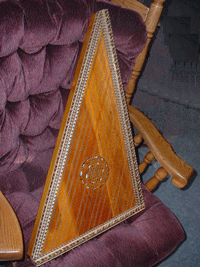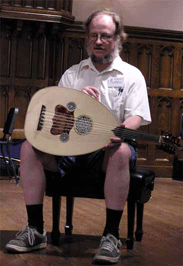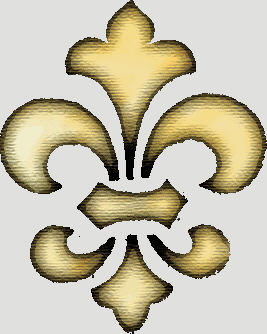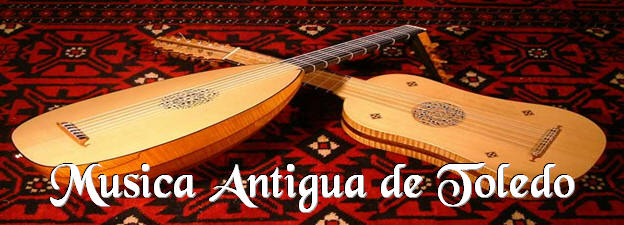|
*Page Under Construction*
Over the years our
instrument collections, both individually and group-owned, have become so
large and varied that it is difficult to give a brief description. Here the
instruments we have (as well as some we don't!) are arranged roughly by time
period (medieval, Renaissance, baroque), and within that, by sound type
(string, wind, percussion). Several of our instruments defy such
classification! An instrument, once invented, may go out of general use, but
it is remembered, and often played, somewhere in the world, only to return
to general use later, as in our own time. Since our site is under
construction, many of these instruments are merely listed; this year we hope
to add not only descriptions and scanned photographs, but also midi sounds
which may be visited by those with midi-capable systems. Watch us for
developments!
Medieval
Renaissance
Baroque
Medieval Instruments (before approx. 1450
CE)
Psaltery

Oud or Ud
 (That's David,
by the way!) (That's David,
by the way!)
Mandora or Gittern
Gittarra latina
Gittarra moresca (saz)
Harp
Vielle (fiedel, fiddle)
Rebec or rebab
Tromba marina
Symphonium or organistrum (sometimes called a hurdy-gurdy, though this name
more properly refers to a 19th century hand organ)
Recorders
Flutes
Both end-blown (like the recorder) and transverse (held horizontally and
blown into a mouth-hole on the side) are known to have been made, usually of
wood. Bone or ivory was occasionally used for the body, but more commonly
to decorate the wood.
Shawms
A double-reed straight-pipe instrument, with a slender cone-shaped bore
inside, which produces a loud, piercing, clear tone. Unlike the later shawms and their descendents, the oboes and English horns, the medieval
shawm reed is not articulated by the lips of the player; the reed is placed
totally inside the mouth.
back to top
Cornetto
Similar to the recorder in material and fingering, but played with a cupped
mouthpiece, using the lips to produce the vibration, as in a modern
trumpet. Often the body was curved slightly, and the inside bore widens
toward the end to give a shawm-like or trumpet-like sound.
Positiv
A large organ, pumped with a pair (or more) of hand bellows to keep a
continous positive pressure so that whenever a key is depressed, a note will
issue from the corresponding pipe. The positiv requires bellows operators
separate from the keyboard player. Organs (except for the portativ) were
all operated this way until the invention of mechanical and then electrical
assistance.
Portativ
A hand organ, played on the lap or a table, pumped with a single bellows,
but by the same player as operated the keys. The portativ does not have
continuous pressure, but must "inhale" like a singer, so that the player
must articulate phrases as a singer would.
Triangle
As the
picture shows, it was usually heavy, closed so that it made a shorter but
deeper sound than the modern triangle. It also had rings around it which
would dance and jangle.
Tambourine
It seems
to have been associated more with the Mediterranian than with the Nordic
countries. The countries of southeastern Europe had very large instruments
with two or even three layers of zils around the rim. In the west smaller
instruments were used, but still with the deep, double rows. Very complex
rhythms were achieved with a variety of finger, hand, and arm motions.
Tabor
(two-sided drum, often with a snare)
This
drum could be short, as in the picture, but it was often taller than its
diameter; it was covered on both ends with skin, and the bottom often had
one or more strings stretched over it, which would buzz when the drum was
struck, like the modern snare drum.
back to top
One-sided hand drum
These
could be small or large; the larger ones had the skin stretched over a
frame. The drum was struck with the hand or with a beater. Sometimes it
could be tuned by turning the rope used to fasten on the skin, but the usual
method for changing tension was to warm the drum head gently near a fire or
by holding next to the player's body for a few moments. The Irish bodhran
is an example.
Nakers
(tuned drums)
A skin
was stretched over a rounded metal bowl and secured with ropes, the tension
of which could be modified to adjust the pitch; ancestral to the kettle
drums in the modern orchestra.
Bones
(paired sticks)
Originally they were actual bones, gently struck together for a knocking
sound. With skill, the player can play very rapid, rhythmic taps,
articulated with the right accents.
Jew's
harp (or jaw harp)
A metal
tine plucked while its frame is in contact with the teeth, for which the
mouth serves as a resonating chamber. The twanging sound can be skillfully
manipulated by moving the mouth
Renaissance (about 1450-1600 CE)
Lute
Like its medieval ancestor, the renaissance
lute is tuned in courses. Each course is a pair of strings at the same
pitch (or in octaves) close enough together so that a single finger-stroke
plays them both. The courses are tuned a perfect fourth apart, except for
between the A (in the tenor size) of course 3 and the F of course 4. The
popular size in the early 16th century was six courses, tuned from the
highest-pitched course 1 at g', course 2 at d', then a, f, c, and low G,
similarly to the tenor size viol. The first course became a single-string
course as players developed virtuosity at playing melodies on it with their
finger-tips instead of using plectra as in the medieval lutes.
Finger-picking allows chord-playing much better than plectra, too, so that
the lute flowered into it's most popular time in history. Players learned
how to do multiple lines in counterpoint, as well as how to play excellent
accompaniments to singers.
Vihuela
The Spanish invented the vihuela (or viola da mano) as a lute in a different
shape from the Moorish oud, to create a distinctive national style. It is
tuned and played like a 6-course lute, but the body shape, and the sound, is
more like the guitar. Like the lute, it comes in different sizes and
pitches.
Guitar
The guitar began in Spain as a treble instrument, small in length and with
only four courses. It shows more relationship to the medieval cithera
family than the lute. The 4-course model in the 16th century was tuned:
a' e'e' c'c' g'g. It was popular for the Spanish cancioneros (folk and
love songs) and the Italian frottole. The high pitch is quite loud when the
instrument is strummed.
Orpharion
This wire-strung instrument is generally tuned
like the lute, but its body is flat-backed, and the sides fancifully
(suggestively?) curved to go with the love music that was usually played on
it. The head at the tuning box is generally carved as a woman's or a god's
head. It is played with a plectrum.
Bandora
This wire-strung instrument is similar in
construction to the orpharion, but it is larger, and tuned a fifth lower.
Also, the bass strings are longer, and the frets and bridge slanted
proportionally. It was usually used in broken consorts, groups of different
instruments, including lute, viol, cittern, and recorders, or with voices.
Cittern
Not to be confused with the gittern, the
cithera, or many other terms for medieval instruments, this wire-strung
plucked instrument is made with a rounded body shape suggesting to us its
descendent, the banjo. The body generally is of wood, and the scroll at the
end of the long neck usually carved to resemble a god's head. It has a
distinctive tuning, different from the lute, and like the banjo, has a high
note tuned among the bass strings, although it is the same length
(re-entrant tuning). It was used in broken consorts as well as for solo
work.
back to top
Haprsichord
Recorders
Flutes
Krummhorns
Cornetto
Sordune
Rackett
Shawms
Sackbut
Organ
Drums
Tambourine
Castanets
Baroque Instruments (about 1600-1800 CE)
Viol
This instrument continued to be used, but less
now in consorts of mixed sizes and more as the bass size for continuo, to
assist harpsichords to make a strong enough bass sound to match the singers
or melody instruments. It also became more of a solo instrument for
virtuosos.
Violone
The great bass viol. Some modern string basses
preserve the shape of this viol closely. There are pictures that show the
player seated, with the instrument extended at an angle in front, like an
oversized cello, instead of standing, as modern bass players do.
Violin
The violin was first known as a gypsy fiddle, a
more powerfully voiced version of the rebec (a medieval bowed instrument
with an internal sound post). Its music during the Renaissance was regarded
as lower class. During the baroque it became more respected as an
instrument with great technical and expressive possibilities. It has
retained this respect to the present, proving itself useful for executing a
wide variety of styles.
Violoncello
This instrument was first built during this period. A member of
the violin family (as opposed to the viols), it began steadily to displace
the viol in orchestras, as it could make the stronger sound valued for the
expressive music used in the masques and pageantry of the 17th century, and
it had an increased pitch range for chamber music.
Lute
The lute
was used extensively in the early 17th century as both accompaniment to
singers and in large lute bands that had various sizes and pitches related
to the most common tenor size by various intervals. At first the lutes were
strung and tuned like the Renaissance instruments; each course was a pair of
strings at the same pitch (or in octaves) close enough together so that a
single finger-stroke would play them both. The courses are tuned a perfect
fourth apart, except for between the A (in the tenor) of course 3 and the F
of course 4. The larger sizes had more and more courses. In France,
particularly, musicians began to experiment with other tuning relationships
that might make the chords of the new baroque music easier to play.
By the
end of the seventeenth century, the lute began to be displaced by bowed
strings for larger compositions, and by guitar for use with songs, but it
continued for solo use, mostly in France and the German areas, where it took
on a very refined quality. These instruments had from 11 to 14 courses, and
each note of the bass octave had its own pair of strings.
Archlute
About 1600, Italian lute-builders began to put long necks on lutes so that
they could accommodate lower bass strings, better to add expression to
accompaniments to song. The first archlutes were tuned like Renaissance
lutes, with extra bass single-string courses adding an entire lower actave.
Theorbo
The
theorbo appeared about the same time as the archlute. It has a similar
shape, with a similar bass octave, but the body is larger, the courses are
all single-string, and the highest courses have been tuned an octave lower,
actually lower in pitch than the third course. This is better for
accompanying bass singers; the single-string courses are played with more
(modern) guitar-like technique. Many theorbists grew their nails long to
use as picks.
back to top
Guitars
The
17th-century guitar retained the octave tuning of its Renaissance
predecessor on the fourth course, and added a fifth course in d, becoming a
slightly larger instrument. Smaller guitars took up re-entrant tuning, in
which both strings of the bass course were on the higher note, at a higher
pitch than the third course. With the strumming style this produced close
harmonies at loud volume. The guitar continued as the instrument of popular
song, but some composers began to create a new repertoire for it with runs
and picking style that began to resemble the Spanish style we now associate
with it. The sixth course, single-strung courses, larger size, and lower
tuning were introduced in the eighteenth century, although double-strung
courses continued to the present in the "twelve-string" folk guitar.
Recorders,
Flutes
Organ
Drums
back to top
|



 (That's David,
by the way!)
(That's David,
by the way!)